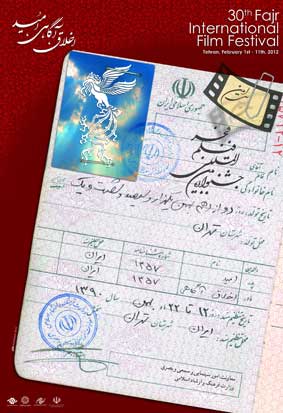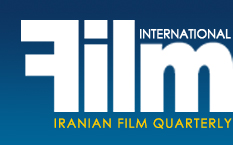|
Fajr International Film Festival
The Great Celebration
by Mehrzad Danesh and Asghar Na’imi
|
 “Tehran International Film Festival” and “Sepas (Gratitude) Festival” (special to one-year productions of the Iranian cinema, were the most prominent cinema events of Iran before the Islamic Revolution in 1979. Following the revolution, cinema (and its festivals) experienced a period of interregnum like many other cultural events, to be redefined on the basis of the new ideology. There were doubts about restitution of cinema for a few years after victory of the revolution and some people even believed that it should be totally dismantled. The first edition of Fajr International Film Festival which was held by a few people interested in cinema at state-run and revolutionary institutions was held under such circumstances. Limited, and futile, efforts had been already made to hold film festivals before that, like Milad Festival in 1981 and Mehrab Festival in 1982. The main goal of Fajr Festival which was held by Ministry of Culture and Islamic Guidance was the keep the Iranian cinema alive under those hectic conditions. If it were not for that festival the Iranian cinema would have been much more limited right now. “Tehran International Film Festival” and “Sepas (Gratitude) Festival” (special to one-year productions of the Iranian cinema, were the most prominent cinema events of Iran before the Islamic Revolution in 1979. Following the revolution, cinema (and its festivals) experienced a period of interregnum like many other cultural events, to be redefined on the basis of the new ideology. There were doubts about restitution of cinema for a few years after victory of the revolution and some people even believed that it should be totally dismantled. The first edition of Fajr International Film Festival which was held by a few people interested in cinema at state-run and revolutionary institutions was held under such circumstances. Limited, and futile, efforts had been already made to hold film festivals before that, like Milad Festival in 1981 and Mehrab Festival in 1982. The main goal of Fajr Festival which was held by Ministry of Culture and Islamic Guidance was the keep the Iranian cinema alive under those hectic conditions. If it were not for that festival the Iranian cinema would have been much more limited right now.
The first edition of the festival was held on February 1-11, 1983. Those ten days are known as 10-Day Dawn in the Islamic Republic’s calendar as they mark the interval between return of the late Ayatollah Khomeini from exile in Iraq to victory of the Islamic Revolution in 1979. Every year, celebrations are held on the occasion to promote achievements of the Islamic Revolution (Fajr is also title of a chapter in the Quran which means “dawn”). Since that time, the festival has been held in that period with few exceptions when it coincided with religious mourning occasions. The goals of the first edition were announced as introducing valuable films made on human issues in other countries which depicted struggles against domineering powers to achieve freedom, independence and self-sufficiency; and to pave the way for exchanges among various countries’ filmmakers. Its various sections included Iranian cinema celebration, outlook of Cuban cinema, Italian cinema from neo-realism up to now, Native Americans and African Americans in cinema, films for children and young adults, and special screenings. Many titles were in line with revolutionary atmosphere of those years. The jury members were never introduced and there were no winners or awards in the first edition. This was probably meant to make the event an uncompetitive one. In the first edition, festival officials cared more about institutionalizing the Iranian cinema than quality of films. That attitude, however, changed in later editions when quality became important.
Festival managers considered it an international event from the very first edition and even claimed that it was an A-grade festival. There were, however, some setbacks. Not all films can be screened in an ideological festival like Fajr. Films containing nudity and eroticism, as well as those against Iran’s ideological fundaments have no place in this festival. Austerity on these issues has reduced international credit of the festival. However, screening of foreign films, especially in the first two decades after the revolution, was a good opportunity for Iranian movie buffs as film officials were against public screening of such films and the festival provided a rare opportunity for Iranian moviegoers to see them. Now, in view of extensive availability of DVDs through unofficial networks, foreign screenings of the festival are not that important.
Participation in Fajr Festival has been of importance to Iranian filmmakers and producers. They assess people’s and critics’ viewpoints to use them in their next movies. The feedback received through the festival is taken by many directors as reference to make corrections to their next works. Some of them even avoid of sending their films to the festival in order to prevent critiques from harming their public screening. High sensitivity about certain films in the festival has, at times, led to prejudgments about them which negatively affected their public screening.
The Fajr Festival has other functions as well. It highlights the importance of cinema in a 10-12-day period when most media outlets focus on films. This is also of high significance to filmmakers because in other times, cinema is not so prominent in the society. The festival increases credit of the Iranian cinema. Many films are premiered in the festival and people stand in long lines to see them before their public screening. Another reason is that some films are subsequently censored or banned from public screens and the festival is the sole opportunity to watch them in their best form.
The 30th edition of the festival this year has, for the first time, a non-state director. Up to last year, its director usually came from Farabi Cinema Foundation (executive arm of the Cinema Department of Ministry of Culture and Islamic Guidance) or another state official was in charge. This year, Mohammad Khazaei, a young producer, is heading the festival. He has been appointed by state officials, but being headed by a private, independent filmmaker is the new feature of this year’s event. Will this change in policy be a prelude to better adaptation of the festival to international standards? This question may be answered after the end of this and next editions of the festival.
During the past 30 years, Fajr International Film Festival has been Iran’s biggest cinema event. Despite shortcomings, its importance has continuously increased. The festival is also the beginning of Iran’s annual cinema calendar. People and filmmakers as well as statesmen and critics look forward to it as an opportunity to assess one-year products of the Iranian cinema in the country’s biggest film celebration.
... To Be Continued
[Page: 30]
|
|
|
|
|
President & Publisher
Massoud Mehrabi
Editors:
Sohrab Soori
Massoud Mehrabi
Translators:
Sohrab Soori
Vazrik Der-Sahakian
Behrouz Tourani
Zohreh Khatibi
Contributors
Mehrzad Danesh
Advertisements
Mohammad Mohammadian
Art Director
Babak Kassiri
Ad Designers
Amir Kheirandish
Hossein Kheirandish
Cover Design
Alireza Amakchi
Correspondents
E.Emrani & M. Behraznia (Germany)
Mohammad Haghighat (France)
A. Movahed & M. Amini (Italy)
Robert Richter (Switzerland)
F. Shafaghi (Canada)
B. Pakzad (UAE)
H. Rasti (Japan)
Print Supervisors
Shad-Rang
Noghreh-Abi
Gol-Naghsh
Subscription & Advertising Sales
Address: 10, Sam St., Hafez Ave., TEHRAN, IRAN
Phone: +98 21 66722444
Fax: +98 21 66718871
info@film-magazine.com
Copyright: Film International
© All rights reserved,
2023, Film International
Quarterly Magazine (ISSN 1021-6510)
Editorial Office: 5th Floor, No. 10
Sam St., Hafez Ave., Tehran 11389, Iran
Printed in Tehran
Publishing Date Summer 2011
*
All articles represent views of their
authors and not necessarily
those of the editors
|
|
|

